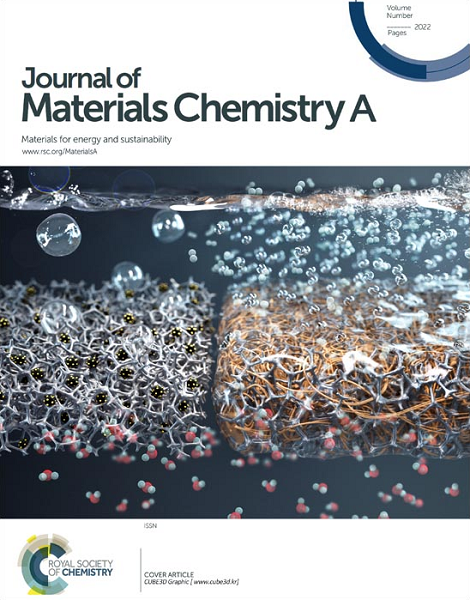A Post-modified Donor-Acceptor Covalent Organic Framework for Enhanced Photocatalytic H2 Production and High Proton Transport
IF 10.7
2区 材料科学
Q1 CHEMISTRY, PHYSICAL
引用次数: 0
Abstract
The production of both the fuel and membrane for proton exchange membrane fuel cells (PEMFCs) often involves disparate materials, therefore, exploring a bifunctional material that can integrate hydrogen source supply and proton conduction is of significant application value in terms of PEMFCs. Herein, we perform a simple post-modification on a donor-acceptor (D-A) COF (PyBT-COF) through converting the abundant cyano group in its pores into carboxyl group (named PyBT-COF-COOH). The minor alteration yields remarkable improvement for PyBT-COF-COOH in photocatalytic hydrogen production activity and endows it with high proton conductivity. With Pt serving as a cocatalyst, PyBT-COF-COOH exhibits significantly improved photocatalytic hydrogen production rate of 8.15 mmol g-1 h-1, over 2.8-fold higher than that of PyBT-COF (2.88 mmol g-1 h-1), and reaches an apparent quantum efficiency of 5.10 % at 420 nm, owing to its enhanced hydrophilicity, dispersion, and carrier separation. The rich proton carriers and exchange binding sites within PyBT-COF-COOH also give it a notable proton conductivity of 4.91 × 10-3 S cm-1 at 353 K and 98 % RH. This study will provide inspiration for developing and utilizing such bifunctional COF materials with both excellent photocatalytic and proton conduction properties in terms of solar-energy conversion.用于增强光催化制氢和高质子传输的后修饰供体-受体共价有机框架
质子交换膜燃料电池(PEMFCs)的燃料和膜的生产往往涉及不同的材料,因此,探索一种能集成氢源供应和质子传导的双功能材料在 PEMFCs 方面具有重要的应用价值。在此,我们对供体-受体(D-A)COF(PyBT-COF)进行了简单的后修饰,将其孔隙中丰富的氰基转化为羧基(命名为 PyBT-COF-COOH)。这一微小的改变显著提高了 PyBT-COF-COOH 的光催化制氢活性,并赋予其较高的质子传导性。在铂作为协同催化剂的作用下,PyBT-COF-COOH 的光催化产氢率显著提高,达到 8.15 mmol g-1 h-1,是 PyBT-COF(2.88 mmol g-1 h-1)的 2.8 倍以上,在 420 纳米波长下的表观量子效率达到 5.10%,这归功于其亲水性、分散性和载流子分离性的增强。PyBT-COF-COOH 中丰富的质子载体和交换结合位点也使其在 353 K 和 98 % RH 条件下具有显著的质子传导性,达到 4.91 × 10-3 S cm-1。这项研究将为开发和利用这种具有出色光催化和质子传导性能的双功能 COF 材料提供灵感,从而促进太阳能转化。
本文章由计算机程序翻译,如有差异,请以英文原文为准。
求助全文
约1分钟内获得全文
求助全文
来源期刊

Journal of Materials Chemistry A
CHEMISTRY, PHYSICAL-ENERGY & FUELS
CiteScore
19.50
自引率
5.00%
发文量
1892
审稿时长
1.5 months
期刊介绍:
The Journal of Materials Chemistry A, B & C covers a wide range of high-quality studies in the field of materials chemistry, with each section focusing on specific applications of the materials studied. Journal of Materials Chemistry A emphasizes applications in energy and sustainability, including topics such as artificial photosynthesis, batteries, and fuel cells. Journal of Materials Chemistry B focuses on applications in biology and medicine, while Journal of Materials Chemistry C covers applications in optical, magnetic, and electronic devices. Example topic areas within the scope of Journal of Materials Chemistry A include catalysis, green/sustainable materials, sensors, and water treatment, among others.
文献相关原料
| 公司名称 | 产品信息 | 采购帮参考价格 |
|---|
 求助内容:
求助内容: 应助结果提醒方式:
应助结果提醒方式:


